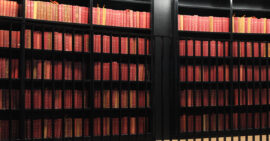On 21 August the Victorian Court of Appeal, by a 2-1 majority, delivered a reserved judgment upholding the conviction of Cardinal George Pell on five charges of sexual offending against a minor, which were said to have occurred in 1996 or early 1997.
The cardinal was convicted after trial before the Chief Judge of the Victorian County Court and a jury. The jury had deliberated for five days and returned unanimous guilty verdicts on all charges. As was his right, Cardinal Pell’s defence team offered no evidence, leaving it to the prosecution to call all of the 22 witnesses, including those expected to give exculpatory testimony. In those circumstances the trial judge gave leave to the prosecution to cross-examine those witnesses within a limited scope and at the same time emphasised that cross-examination of two key witnesses which might have tended to suggest that they “held any allegiance” to Pell, “whether consciously or unconsciously”, would not be permitted, because
…this trial is being conducted within a broader atmosphere of a perceived cover-up of child abuse within the Catholic Church. … In my view [the trial judge said], terms such as allegiance or loyalty, especially in the context of this case, are … pregnant with suggestions of a deliberate or calculate decision to protect the accused or perhaps the Church … . If such questioning does not raise the issue of perjury, it goes perilously close. … In my view, it would be unfair to the accused to allow such questioning, in circumstances where the prosecution, on the state of the evidence as it stands, eschews any allegation that these witnesses are lying.
The jury was given a clear direction requiring them to take into account the fact that the events giving rise to the alleged offences had taken place many years previously and that the delay in prosecuting them put the defence at a “forensic disadvantage”, not having had the opportunity to gather exculpatory evidence at or close to the time of the alleged offending. This meant that evidence favouring the accused could only relate to general practice or routine, instead of any specific recollection. The intervening death of a material witness (and potentially a second complainant) was also directed to be taken into account as a forensic disadvantage to the defence.
At the conclusion of the evidence (which, by available accounts was extensive), the trial judge summed up in a manner that was “clear, balanced and scrupulously fair”.1
There can be no doubt from what the appeal judgments disclose that Pell received a fair trial.
The cardinal contentions before the Court of Appeal
Cardinal Pell sought leave to appeal against his convictions, positing three grounds. The main ground challenged the jury’s guilty verdicts as unreasonable and incapable of being supported having regard to the evidence. Leave was granted to appeal on that ground alone. The application and appeal were heard over two days in June 2019.
Findings on appeal
The issues in the appeal were exclusively factual and required the court to decide whether, on the whole of the evidence, it was open to the jury to be satisfied beyond reasonable doubt that the accused was guilty. This in turn required the court not to disregard or discount the role of the jury as “the body entrusted with the primary responsibility of determining guilt or innocence, or the consideration that the jury has had the benefit of having seen and heard the witnesses”2.
Two issues were identified: first, was the complainant’s uncorroborated evidence of the offences credible; and second, did the events of the day in question furnish Pell with an opportunity to do what was alleged against him?
In its task of putting itself as far as possible into the jury’s “shoes”, the court read through some 2000 pages of transcript, viewed video recordings of some of the oral evidence and took a view at St Patrick’s Cathedral in Melbourne. Like the trial jury, they also inspected clerical vestments of the type worn by Pell when the offences were committed and were given the opportunity to try them on.
Chief Justice Ferguson and Court of Appeal President Maxwell found that the complainant was a witness of truth. In their view, he did not seek to embellish or tailor his evidence and aspects of it could not have been invented (such as precisely and, as it happened, accurately identifying both the room where the offences occurred and where the sacramental wine was kept). He made appropriate concessions as to things that he could not remember accurately and “his explanations of why that was so had the ring of truth. … Both the content of what he said and the way in which he said it – including the language he used – appeared to us to be entirely authentic.”3 He also withstood a prolonged and searching cross-examination by experienced senior defence counsel, who sought unsuccessfully to portray him as a fantasist.
RELATED: 5 Cases We’re Talking About Halfway Through 2019
The majority also rejected the defence argument that it was impossible for the offences to have occurred because Pell would have had no opportunity to be alone and/or unobserved at any relevant time and that his robes would have prevented him from committing the acts alleged. In their Honours’ view, a detailed consideration of the evidence did not compel a finding that there was no opportunity to offend or raise a reasonable doubt about Pell’s guilt.
In a lengthy and detailed dissenting judgment, Appeal Justice Weinberg analysed the complainant’s evidence closely and came to the view that the complainant did embellish aspects of his account and
[o]n occasion, … seemed almost to ‘clutch at straws’ in an attempt to minimise, or overcome, the obvious inconsistencies between what he had said on earlier occasions, and what the objective evidence clearly showed. … I would not myself be prepared to say, beyond reasonable doubt, that the complainant was such a compelling, credible, and reliable witness that I would necessarily accept his account beyond reasonable doubt. 4
While it could not be concluded that the complainant invented the allegations, Weinberg JA found that there was a significant body of evidence that cast serious doubt on his account, both as to credibility and reliability. His Honour accepted the evidence of Pell’s Master of Ceremonies and others that it was invariable church practice never to leave a bishop alone when robed and that the ritual procession at the conclusion of Sunday observances invariably followed the same pattern, such that the opportunity to offend could never have arisen. Moreover, his Honour accepted the Master of Ceremonies’ evidence concerning the Archbishop’s robes
as containing a vast amount of material, with a circumference of almost four metres. When [counsel] asked him what the Archbishop did when he went to the toilet, [the witness] sardonically remarked ‘well you just don’t’.5
Justice Weinberg accepted the defence’s proposition that a substantial body of evidence left open a “reasonable possibility” that the allegations fell short of the standard of proof required for conviction. His Honour would have allowed the appeal and ordered verdicts of acquittal on all counts.
Onward and upward – to the High Court
On 17 September, Pell’s lawyers filed an application for special leave to appeal to the High Court of Australia.
Applications for special leave are circumscribed by section 35A of the Judiciary Act 1903 (Cth), which largely confines High Court appeals to questions of law. As mentioned above, the Pell case has always turned on issues of fact. Alternatively, the court may agree to take the case having regard to whether the interests of the administration of justice “require consideration by the High Court of the judgment to which the application relates” (in this case, the judgment of the Court of Appeal).
In their submissions, Pell’s team argue that the majority of the Court of Appeal got their overall assessment of the evidence wrong, but the credibility of the complainant is no longer being called into question. Rather, the focus is now on the court’s assessment of the “opportunity” evidence and whether too high a threshold of reasonable doubt was set – effectively reversing the onus of proof and, contrary to the proper administration of justice, requiring Pell to prove his innocence.
It is on that thread that Pell’s hopes hang.
[1] Pell v The Queen [2019] VSCA 186 at [17]
[2] M v The Queen (1994) 181 CLR 487, 493.
[3] Pell v The Queen [2019] VSCA 186 at [91], [94]. [1] Ibid. at [928]. [929].
[4] Ibid. at [928]. [929].
[5] Ibid. at [472].


